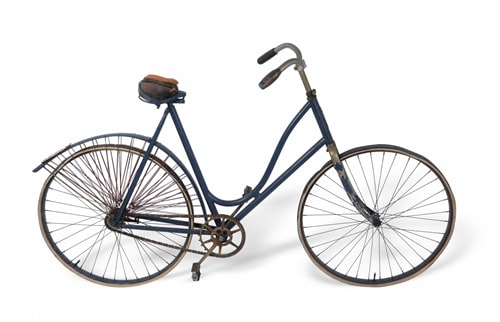Wisconsin went crazy for bicycling in the late 19th century. Hailed as “the most independent, healthful, rapid, and convenient mode of travel” in the 1890s, Wisconsinites not only rode bikes, they made them.
The Kenosha-made Sterling Safety Bicycle is a women’s safety bicycle with a lowered top tube to accommodate for dresses and skirts that were fashionable for women in the 1890s. Cycling was dominated by men during this time, but women often rode with male counterparts or with groups of friends on excursions out of the city into the countryside. This bicycle would have served any recreational user of the 1890s well.
The American Bicycle Company manufactured the Sterling Safety Bicycle in the late 1890s. Originally made in Chicago by the Sterling Bicycle Company, bicycle production shifted to Kenosha in 1899 when Sterling and other manufacturers came together to form the American Bicycle Company.
Bicycles entered Wisconsin as early as January 7, 1869 and grew in popularity until the Milwaukee Sentinel reported on June 29, 1890 “that no sport of the present century has grown so rapidly in popular favor as bicycling.” By 1880, bicycling in the U.S. had become so popular that the League of American Wheelmen (LAW) was founded with local chapters around the country, including dozens in Wisconsin. These organizations of wheelmen, as bikers were known at the time, worked to popularize and improve bicycling.
The crowning achievement of the Wisconsin wheelmen’s efforts to improve their sport was the Wisconsin Tour and Hand Book and its accompanying map collection. The tour book was a pocket-sized manual that people could take on trips to help navigate throughout Wisconsin. The book pointed out the best roads for travel, hotels, restaurants, and shops.
Documenting road conditions became a primary concern of Wisconsin’s cyclists. Many of the nation’s roads were so rough as to make bicycling incredibly difficult. Wheelmen hoped to grow the number of paved roads to help their sport. They also appealed to farmers for help, arguing that paved roads would make it easier for farm products to reach markets.
The wheelmen ultimately failed to improve Wisconsin’s roads, and conditions in the state remained poor into the 20th century. Add to this the growth of the automobile industry that caused the collapse of the bicycling craze.
This story was produced in partnership with Wisconsin 101, a collaborative effort to share Wisconsin’s story in objects.










